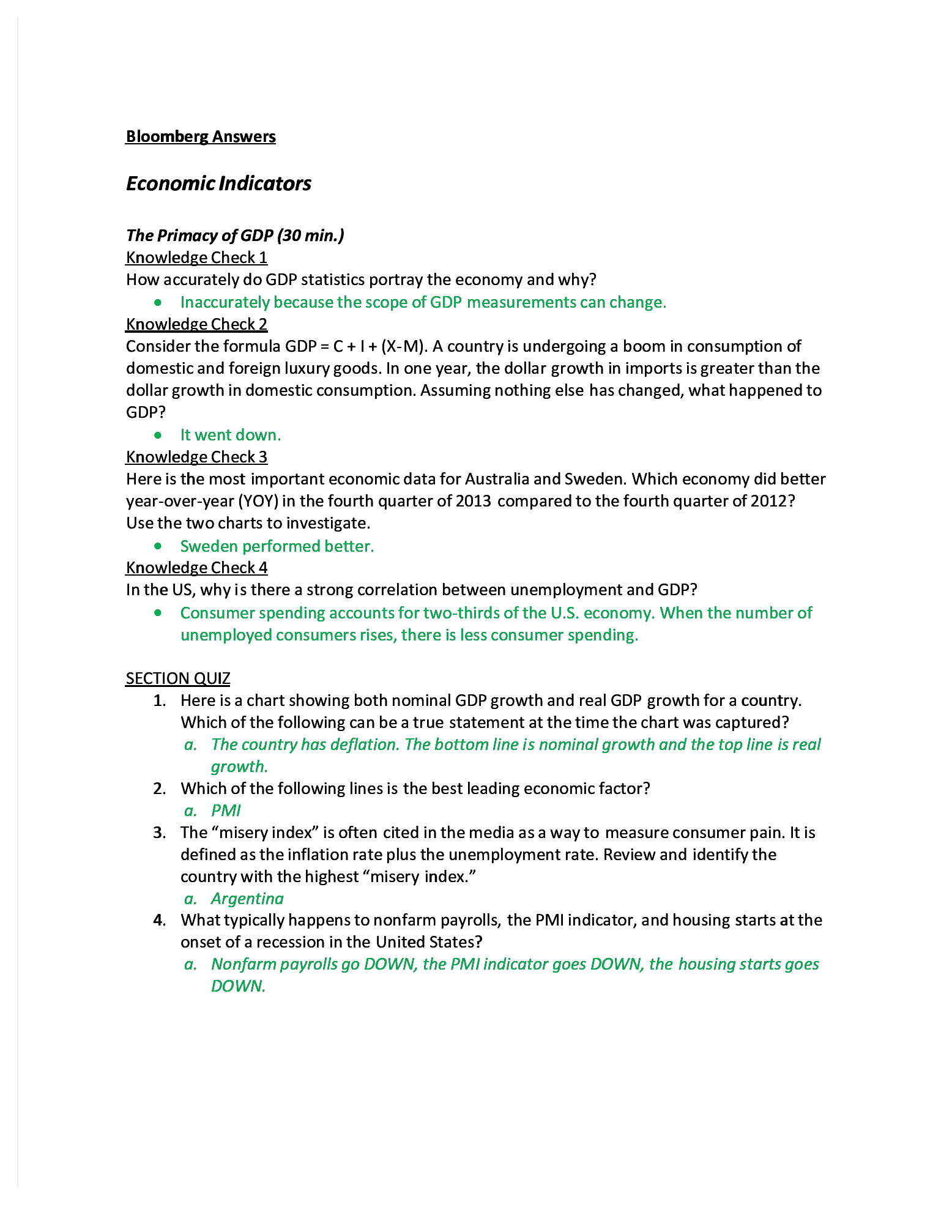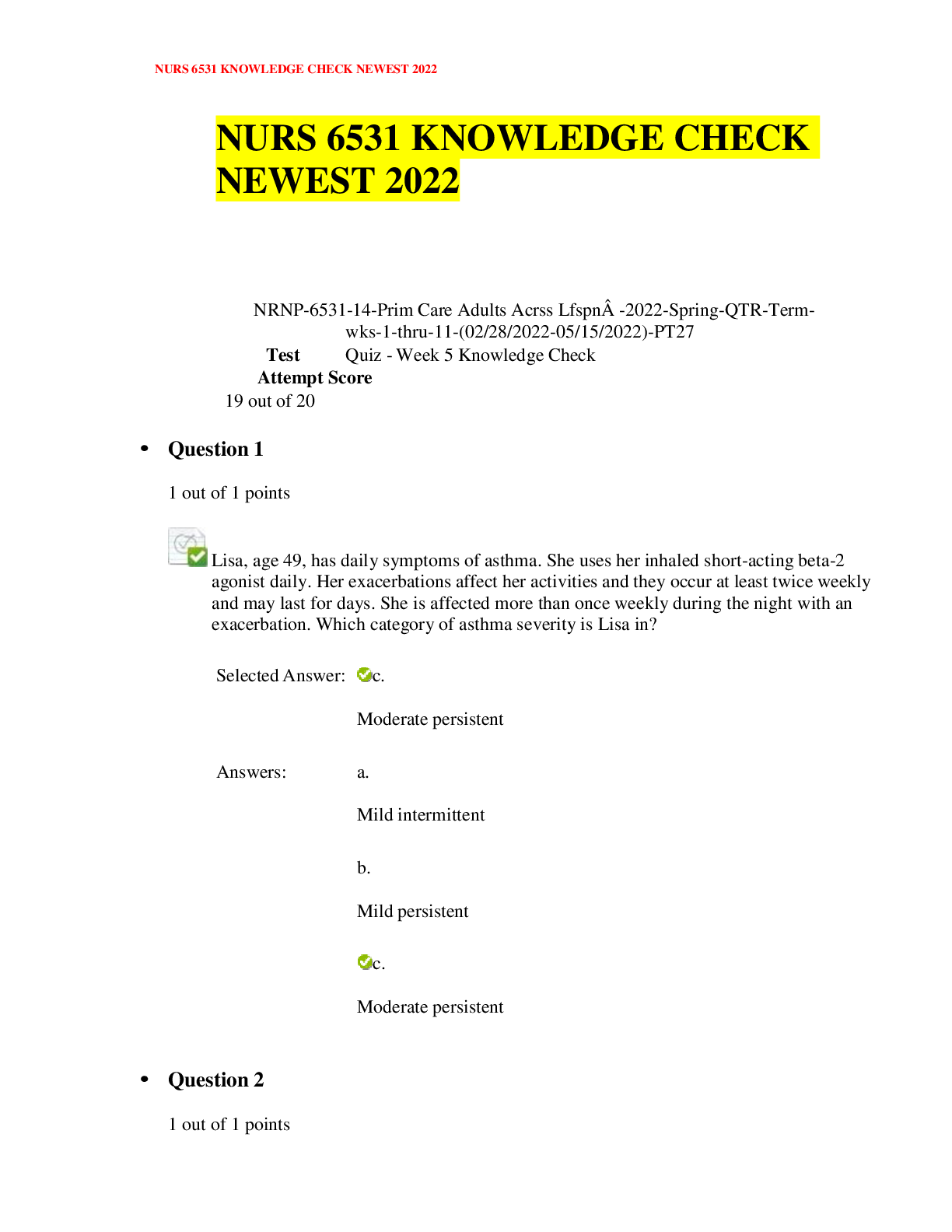Health Care > QUESTIONS & ANSWERS > RPN Fluids and Electrolytes Practice Test (All)
RPN Fluids and Electrolytes Practice Test
Document Content and Description Below
RPN Fluids and Electrolytes Practice Test 1. The patient with the highest percentage of body weight as water is: a. Johnny, 78 years old. b. Peter, 45 years old. c. Lucy, 16 years old. d. Robert ... 3 days old. 2. Lisa, 35-year-old female client, admitted with a diagnosis of dehydration secondary to 3-day history of diarrhea is receiving an IV of 0.9 NS at 120 ml/hour. In 2 ½ hours the client received 390 ml. The IV infusion is said to be a. 45 minutes ahead. b. 45 minutes behind. c. 15 minutes behind. d. 15 minutes ahead. 3. If the potassium level of the patient is 5.6. The PN would do which of the following: a. Inform the nurse in charge. b. Observe the patient. c. Monitor the patient’s vital signs. d. Inform the physician. 4. The practical nurse’s assessment indicating dehydration would include signs and symptoms of a. Clubbing of fingers and toes b. Patient complains of feeling cold and chilly c. Dry mucous membrane; decreased urine output d. Patient has a fever 5. What is the most appropriate way to take the temperature of an 18-month old with severe diarrhea? a. Rectal b. Oral c. Axillary d. Do not take the temperature 6. Joe, 69-year-old client, is on IV therapy. The PN assigned to him has noticed that he receives 300 ml of fluids in an hour. The most appropriate initial action by the PN would be to a. Check the client`s apical pulse and determine if it went lower than his normal pulse b. Maintain the client in a supine position c. Administer oxygen 2 d. Place the client in an upright position 7. The following are signs and symptoms of blood transfusion reaction: a. Pain at the intravenous site, rashes all over the body, palpitations b. Dysphagia, diplopia, hematuria c. Hypertension, back pain, confusion d. Flank pain, hypotension, fever 8. After a successful surgery, the client was noted to have a urine output of 800 ml. Four hours later, she voided another 400 ml. Based on the PN’s findings, the most appropriate nursing action would be which of the following? a. Consider this as normal finding. b. Collect urine sample for urinalysis. c. Record the finding in the progress note. d. Consult the nurse in charge. 9. The PN who is assigned to the patient receiving blood transfusion is aware that one of the following is essential: a. Expect the use a blood warmer during blood transfusion. b. Expect the blood, one unit, to be transfused in 4 to 5 hours. c. Closely monitor the child for possible blood transfusion reaction during the first few minutes of blood transfusion. d. Monitor the child’s vital signs every 30 minutes. 10. Due to prolonged bedrest, Mrs. Cox is very prone to skin breakdown. Which of the following nursing action will promote the patient’s skin integrity? a. Massage the patient’s bony prominences with cream. b. Apply liberal amount of talcum powder and alcohol to the patient’s dry skin. c. Turn the patient every 2 hours and avoid wrinkles on the bedsheets. d. Wash the patient’s skin daily with soap and warm water and keep it dry at all times. 11. The patient with asthma received bronchodilator and an IV infusion was started. Because the patient is restless and confused, which of the following methods would be best for the PN to use in taking his vital signs? a. Take an apical pulse and a rectal temperature. b. Take radial pulse and an oral temperature. c. Take a pedal pulse and a rectal temperature. d. Take a radial pulse and a rectal temperature. Terry has vomiting and diarrhea. He is dehydrated. 3 12. Which of the following nursing intervention is most appropriate for Terry’s condition? a. Weigh patient daily, monitor for bulging fontanel, and poor skin turgor. b. Monitor for sunken fontanel, increased apical pulse, and decreased urine output. c. Check for poor skin turgor, IV fluids, reversed isolation. d. Weigh patient twice daily, cuddle the baby when crying, IV fluids. 13. Which of the following assessment accurately determine fluid loss in a 78-year- old male patient with dehydration? a. Urine specific gravity is lesser than normal. b. Dry mucus membrane and delayed capillary refill. c. Loose skin and poor skin turgor. d. Pull the skin around the chest and weigh daily. 14. A 72-year- old mother, taken cared by her daughter at home, has incontinence episodes. Which of the following health teachings provided by the PN to the daughter best promote skin integrity? a. Wash the patient’s perineum with soap and water after each incontinence episode. b. Instruct the daughter to wash and apply skin barrier and incontinent pad. c. Encourage the daughter to frequently reposition the patient [Show More]
Last updated: 1 year ago
Preview 1 out of 193 pages
Instant download

Buy this document to get the full access instantly
Instant Download Access after purchase
Add to cartInstant download
Reviews( 0 )
Document information
Connected school, study & course
About the document
Uploaded On
Feb 09, 2023
Number of pages
193
Written in
Additional information
This document has been written for:
Uploaded
Feb 09, 2023
Downloads
0
Views
32





